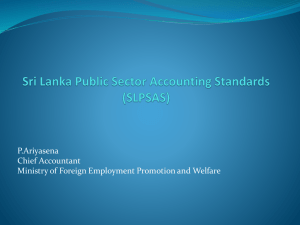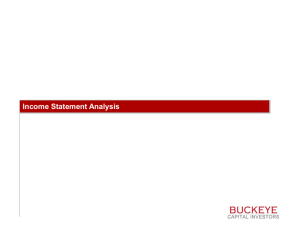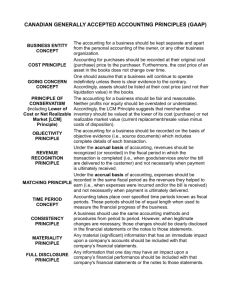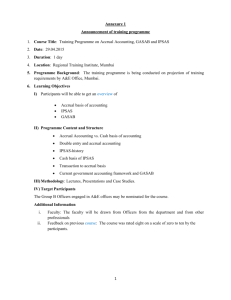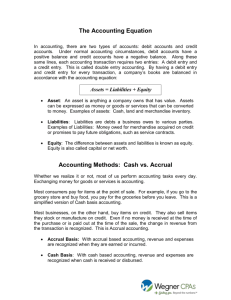Tips on Accrual Basis Accounting
advertisement
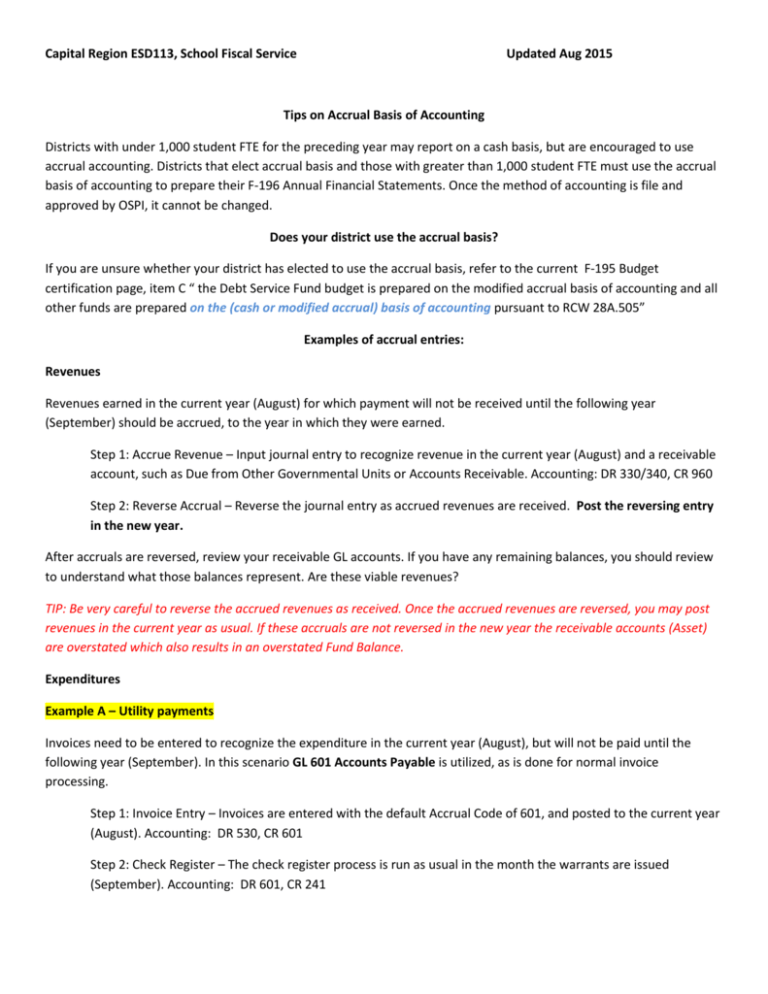
Capital Region ESD113, School Fiscal Service Updated Aug 2015 Tips on Accrual Basis of Accounting Districts with under 1,000 student FTE for the preceding year may report on a cash basis, but are encouraged to use accrual accounting. Districts that elect accrual basis and those with greater than 1,000 student FTE must use the accrual basis of accounting to prepare their F-196 Annual Financial Statements. Once the method of accounting is file and approved by OSPI, it cannot be changed. Does your district use the accrual basis? If you are unsure whether your district has elected to use the accrual basis, refer to the current F-195 Budget certification page, item C “ the Debt Service Fund budget is prepared on the modified accrual basis of accounting and all other funds are prepared on the (cash or modified accrual) basis of accounting pursuant to RCW 28A.505” Examples of accrual entries: Revenues Revenues earned in the current year (August) for which payment will not be received until the following year (September) should be accrued, to the year in which they were earned. Step 1: Accrue Revenue – Input journal entry to recognize revenue in the current year (August) and a receivable account, such as Due from Other Governmental Units or Accounts Receivable. Accounting: DR 330/340, CR 960 Step 2: Reverse Accrual – Reverse the journal entry as accrued revenues are received. Post the reversing entry in the new year. After accruals are reversed, review your receivable GL accounts. If you have any remaining balances, you should review to understand what those balances represent. Are these viable revenues? TIP: Be very careful to reverse the accrued revenues as received. Once the accrued revenues are reversed, you may post revenues in the current year as usual. If these accruals are not reversed in the new year the receivable accounts (Asset) are overstated which also results in an overstated Fund Balance. Expenditures Example A – Utility payments Invoices need to be entered to recognize the expenditure in the current year (August), but will not be paid until the following year (September). In this scenario GL 601 Accounts Payable is utilized, as is done for normal invoice processing. Step 1: Invoice Entry – Invoices are entered with the default Accrual Code of 601, and posted to the current year (August). Accounting: DR 530, CR 601 Step 2: Check Register – The check register process is run as usual in the month the warrants are issued (September). Accounting: DR 601, CR 241 Example B – Goods or services purchased that will not be consumed in the current year Invoices need to be entered to recognize the expenditure in the following year (September), but will be paid in the current year (August). In this scenario GL 430 Prepaid Items is utilized. (Screen shot below.) Step 1: Invoice Entry – Invoices are entered selecting the Accrual Code of 430 (Prepaid Items), and are posted to the following year (September). Accounting: DR 530, CR 430 Step 2: Check Register – The check register process is run as usual in the month the warrants are issued (August). Accounting: DR 430, CR 241 Check registers should always be posted to the month in which the warrants are issued. In Summary 1. I want to post ahead to the following year (it’s August and booking it for next year) a. Post the invoices to September. b. If it’s a prepaid item, select the Accrual Summary Account 430. c. Checks are always posted in the same month they are issued. 2. I want to post back to the preceding year (it’s September and booking it for the previous year) a. Post the invoices to August. b. Checks are always posted in the same month they are issued. Prepaid Items Generally, prepaid items refer to services to be provided (consumed) in a future fiscal period but for which payment has been made in a prior fiscal period. Expenditures of these items are prorated to the period during which the services were provided. The value of tangible materials acquired for future fiscal period consumption may be debited to prepaid items when timing of the expenditure is relevant to the proper recognition of expenditures. This situation arises primarily at the end of one fiscal period and the beginning of another and generally involves districts using the periodic method of inventory. 2015-16 Accounting Manual, Chapter 3- Accounting Guidelines 3-17 Modified Accrual Basis. The accrual basis of accounting adapted to the governmental fund-type measurement focus. Under it, revenues and other financial resource increments (e.g., bond issue proceeds) are recognized when they become susceptible to accrual, which is when they become both “measurable” and “available to finance expenditures of the current period.” “Available” means collectable in the current period or soon enough thereafter to be used to pay liabilities of the current period. Expenditures are recognized when the fund liability is incurred except for (1) inventories of materials and supplies that may be considered expenditures either when purchased or when used and (2) prepaid insurance and similar items that may be considered expenditures either when paid or when consumed. All governmental type funds are accounted for using the modified accrual basis of accounting. An exception to this method is when a school district with 1,000 or less full-time equivalent students makes an election to use the cash basis of accounting: 2015-16 Accounting Manual, Appendix A-Glossary of Terms A-37 Examples of Accrual Entries Revenues: TAXES RECEIVABLERecognize outstanding property tax as of August 31 POST TO AUGUST REVERSE IN SEPTEMBER GENERAL LEDGER 310 760 SUBSIDIARY ACCOUNTS GENERAL LEDGER 760 310 SUBSIDIARY ACCOUNTS DESCRIPTION Taxes Receivable Unavailable Revenue TR DEBIT $ 1,000.00 DESCRIPTION Unavailable Revenue TR Taxes Receivable DEBIT $ 1,000.00 CREDIT $ 1,000.00 CREDIT $ 1,000.00 DUE FROM OTHER GOVT UNTS (GL 330)/ACCOUNTS RECEIVABLE (GL 340) Revenues earned in August, but not received until September; i.e. late grant claims (330) POST TO AUGUST POST TO SEPTEMBER GENERAL LEDGER 330 960 SUBSIDIARY ACCOUNTS GENERAL LEDGER 230 330 SUBSIDIARY ACCOUNTS Yes DESCRIPTION Due from Other Govt Revenue DESCRIPTION Cash on Hand Due from Other Govt $ DEBIT 500.00 CREDIT $ DEBIT $ 500.00 500.00 CREDIT $ 500.00 UNAVAILABLE INFLOWS OF REVENUE (GL 750) Revenues received in August, but not available to use until September; i.e.: tuition, lunch money POST TO AUGUST POST TO SEPTEMBER GENERAL LEDGER 230 750 SUBSIDIARY ACCOUNTS GENERAL LEDGER 750 960 SUBSIDIARY ACCOUNTS Yes DESCRIPTION Cash on Hand Unavailable Revenue DEBIT $ 500.00 DESCRIPTION Unavailable Revenue Revenue DEBIT $ 500.00 CREDIT $ 500.00 CREDIT $ 500.00 Expenditures: PREPAID ITEMS Items paid for in August, but recognized in September. This can be processed through the AP system. POST TO AUGUST Checks issued this month POST TO SEPTEMBER Invoices recognized GENERAL LEDGER 430 241 SUBSIDIARY ACCOUNTS GENERAL LEDGER 530 430 SUBSIDIARY ACCOUNTS Yes DESCRIPTION Prepaid Items Warrants Outstanding DEBIT $ 1,000.00 DESCRIPTION Expenditures Prepaid Items DEBIT $ 1,000.00 CREDIT $ 1,000.00 CREDIT $ 1,000.00 INVOICES RECOGNIZED IN AUGUST, BUT NOT PAID UNTIL SEPTEMBER Utility payments and other services, supplies and materials. This can be processed through the AP system. POST TO AUGUST Invoice is posted to August POST TO SEPTEMBER Check Register processed in September GENERAL LEDGER 530 601 SUBSIDIARY ACCOUNTS Yes GENERAL LEDGER 601 241 SUBSIDIARY ACCOUNTS DESCRIPTION Expenditures Accounts Payable DESCRIPTION Accounts Payable Warrants Outstanding DEBIT $ 500.00 CREDIT $ $ DEBIT 500.00 500.00 CREDIT $ 500.00
